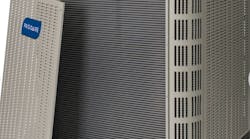Could ammonia and carbon dioxide gain ground as new and trendy refrigerants? Trendy, maybe. But they're really not all that new.
Early on, both were commonly used as refrigerants, although they presented serious problems at the time — ammonia is toxic, and carbon dioxide requires high pressures to effectively operate in a refrigeration cycle.
Enter dichlorodifluoromethane, or R-12 — a stable, nontoxic fluid which operates at pressures high enough where, if leakage occurred, air would not leak into the system and technicians could recharge it without the use of a vacuum.
R-12 was, therefore, the refrigerant of choice for years. It was nearly flawless except for one huge side effect — when leaks do occur, the refrigerant makes its way into the atmosphere and breaks down the ozone layer.
This resulted in the banning of R-12 on a global scale, with chlorine-free tetrafluoroethane (R-134A) replacing it. While not as stable as R-12, R-134A does not deplete the ozone layer when it leaks into the atmosphere, many believe.
But even R-134A isn't the be-all, end-all of refrigerants, for now the scientific consensus is that this seemingly ozone-safe refrigerant does have a global warming potential (GWP) and will be barred from automobile air-conditioning systems in Europe within a few years.
And so, two of our new options are old options: none other than ammonia and carbon dioxide as refrigerants.
While the requirement of high pressure and high compressor temperature for effective use of carbon dioxide posed a problem in the past, many in Europe believe those same two requirements make carbon dioxide an ideal refrigerant today.
The high cycle pressure results in high fluid density throughout the cycle, allowing smaller systems for the same heat-pumping power requirements of other systems. Add to this its good environmental properties, and you find renewed interest in carbon dioxide as a refrigerant.
Added technical guidance about the use of carbon dioxide is available from The American Society of Heating, Refrigerating and Air-Conditioning Engineers (ASHRAE) 2006 handbook for refrigeration.
Early global use of carbon dioxide in cooling applications would avoid regulatory challenges and help developing countries reduce emissions substantially while remaining competitive, according to German and European Commission officials speaking at an international refrigeration conference, CO2Ol Food — Climate-Friendly Refrigeration in Supermarkets, held in Berlin on May 23.
Natural refrigerant carbon dioxide will be the most viable solution for the refrigeration industry worldwide, with key advantages regarding environmental performance, economic benefits and legal security, according to Dr. Uwe Lahl, director general of the German Ministry for the Environment.
CO2
Carbon dioxide as an HVACR refrigerant has benefits and challenges, according to Warren Beeton, Emerson Climate Technologies. On the plus side, he says it does have a low GWP, low costs (compared with HFCs) and excellent heat transfer. On the negative side are high operating pressures, increased system costs and what he called “low efficiency of the basic cycle.”
Currently in refrigeration, carbon dioxide serves as a secondary coolant in hot water heating heat pumps, in some low temperature systems and in Europe as automotive air-conditioning.
Danfoss has been a strong advocate of the carbon dioxide option. Jens Callesen, the company's business development manager for carbon dioxide, was quoted in the British trade publication RAC as saying, “I believe carbon dioxide is the long-term solution because we have not seen any other solutions yet from the established refrigerant suppliers.”
In the United States, some food service refrigeration/freezing companies use carbon dioxide as a secondary coolant along with an HFC. It also has use in industrial applications in conjunction with ammonia in cascade systems. Recent efforts in the United States to pass sweeping climate change legislation that would limit HFC supplies have motivated some commercial customers to reconsider carbon dioxide and ammonia systems. However, there still remain significant challenges for these alternatives.
New Solutions from Luvata
With environmental impact a key concern for the entire HVACR industry, global metals manufacturing and technology company Luvata has further developed the use of carbon dioxide as a refrigerant in its new solutions.
From an environmental point of view, carbon dioxide is a superior alternative to environmentally damaging HFCs, as well as being nonflammable, nontoxic and less expensive. Luvata has explained that, as well as potentially offering zero ozone depletion and less effect on global warming, the use of carbon dioxide can also allow more- efficient operation of the system than traditional refrigerants.
The Coca-Cola Co. selected the technology, developed by Luvata's coils and coolers division, for use in environmentally friendly vending machines for the 2008 Beijing Olympics as part of the global beverage company's commitment to sustainability.
Giovanni Simeoni, head of Sales and Marketing, Product Development and R&D for Luvata's ECO-Heatcraft division, explained the benefits of using CO2 as a refrigerant: “In addition to the environmental advantages, it has a higher heat-transfer coefficient than traditional refrigerants, which can lead to increased efficiency in the heat-transfer equipment it is used in. The higher volumetric efficiency of CO2 refrigerant (known as R-744) also means that the cross-sectional area of pipes used in heat-transfer equipment can be reduced. As a result, equipment has the potential to be smaller, lighter, more efficient and better for the environment.”
Ammonia
As a refrigerant, ammonia offers three distinct advantages over other commonly used industrial refrigerants. First, ammonia is environmentally compatible — like carbon dioxide, it doesn't deplete the ozone layer and doesn't contribute to global warming. Second, ammonia has superior thermodynamic qualities, so as a result, ammonia refrigeration systems use less electricity. Third, ammonia's recognizable odor is its greatest safety asset — leaks are easily detectable.
Restrictions on chlorine- and fluorine-containing refrigerants have focused attention on ammonia with its emergence as one of the widely used, environmentally friendly refrigerants.
It's an especially efficient refrigerant for use in food processing and preservation, as well as other refrigeration and air-conditioning processes. For more than a century, ammonia's desirable characteristics as a refrigerant have been common knowledge. However, ammonia's toxicity remains a significant challenge.
ASHRAE considers that the continued use of ammonia is necessary for food preservation and air conditioning. ASHRAE promotes a variety of programs to preserve the economic benefits of ammonia refrigeration while providing for the management of risks.
Applications for ammonia-based refrigeration systems include thermal storage systems, HVACR chillers, process cooling and air conditioning, district cooling systems, supermarkets, convenience stores, air conditioning for the International Space Station and Biosphere II, and increasing output efficiencies for power generation facilities.
One HARDI distributor member noted that the industry has spent recent years converting existing CFC systems to HCFC and HFC products. To go back to these end-users and tell them that they once again need to change out their existing systems with new equipment and new refrigerants would be a very tall task.
This HARDI distributor noted that, “Although ammonia has proven to be a very effective refrigerant, it also brings a set of challenges to the table, including a huge lack of technicians properly trained in the proper usage of this gas.
“While CO2 and ammonia may have a much lower ozone-depletion capacity, there may be a negative in terms of the total ‘carbon footprint' associated with these new gases. I don't know if burning more coal to generate the needed power to run these systems is a good trade-off for the lowered ozone depletion.
“While there is a lot of talk in Europe surrounding CO2 for the automotive market, there is also a lot of activity in the United States in regards to very low-GWP alternatives. No one really knows where this will end up.”
Exciting? Maybe. Interesting? Certainly. New refrigerants? Not really. How will ammonia and carbon dioxide fit into the future? That will remain a question until we see what new alternative refrigerants are introduced into the mix. In the meantime, it is important that all factors relating to these not-so-new substitutes are considered before our industry starts to talk about yet another transition.
Pete Grasso is former associate editor of Contracting Business magazine. Contact him at [email protected].





